Here’s one of our favorite recipes of an Indian sweet snack, the Shakarpara or Khurma. Shakkarpare (in plural) is one of the quintessential Diwali treats that can be found in almost every corner of the Indian subcontinent. Though with different regional names, this snack is usually diamond-shaped, crunchy, flaky and fried flour cookies coated with crystallized sugar. Try my authentic Punjabi recipe of this scrumptious snack that you can literally munch on, any time!
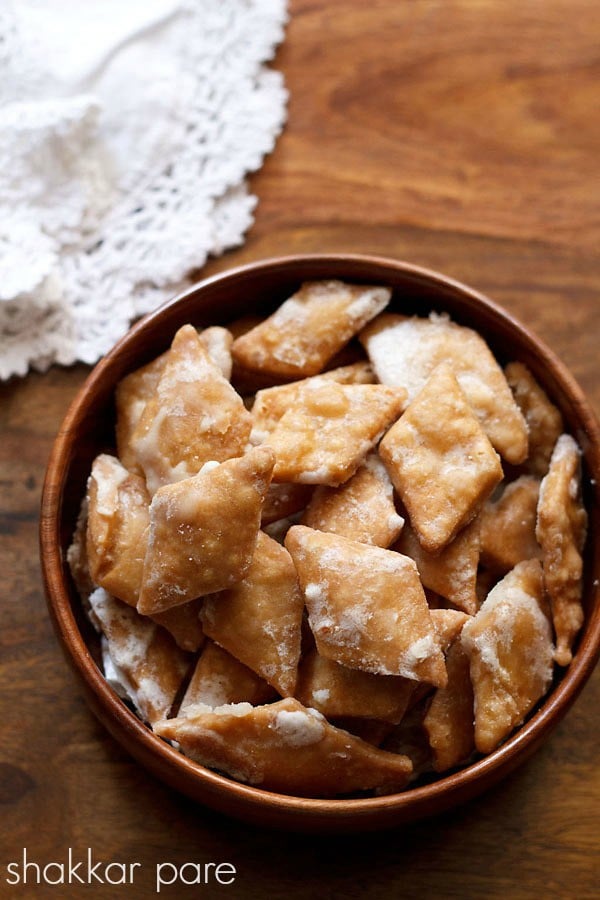
What is Shakkarpara
In India, Shakarpara is one of those snacks, which is quite ubiquitous during the Diwali festive season. It is not only popular in North Indian and Gujarati cuisines, but is also a common feature in weddings and special occasions in other parts of the country.
The various Indian regional versions are shankarpali (Maharashtra), shankarapoli/shankarapali (Karnataka), shakerpara (West Bengal) and khurma (Bihar/Nepal).
Not just these, this particular snack is also famous outside India like Fiji (where it is called lakdi mithai), Trinidad and Tobago, United Kingdom, Guyana, etc.
According to many food historians, the origin of Shakarpare can be said to be in ‘shekarpareh,’ which is a sweet pastry snack from the Iranian cuisine.
The main ingredients of Shakarpare include a dough made of either all-purpose flour (maida) or whole wheat flour (atta), ghee and sugar. Some people may also add a bit of semolina (suji/rava) and some flavorings.
Just like my Shakarpara recipe, which is made with atta and has a saffron flavored sugar syrup too. This sweet snack is usually deep-fried. However, these days you may air-fry them too.
More On My Recipe
At home, I usually make Shankarpali during the festival of Diwali. The method of making this Maharashtrian version is different than the preparation of Shakkarpare.
What makes Shankarpali snack distinct is that in it, the sweet dough is not coated with sugar syrup. On the other hand, Shakkarpara or Khurma is made with an unsweetened dough and once fried, it is coated with sugar syrup. So, the taste and texture of both these versions are completely different.
The initial part of making the dough for Shakkarpare, and frying is easy. However, you need to pay attention while making the sugar syrup. It should be of the right consistency, which is of 2 or 3 threads.
Also, this recipe uses sugar, but you can also use jaggery and turn it into gudpare. The same amount of jaggery can be added.
Making any sweet or savory for Diwali is a time-consuming task. So, make sure to complete all your chores before dedicating the time in the preparation of these sweets and savories.
From 240 grams (2 cups) of whole wheat flour, I got 450 grams of Shakarpara. A little less than ½ a kilogram. The recipe can be scaled by doubling or tripling the quantities.
How to make Shakkarpara
Make this special sweet snack easily in your kitchen, with my step-by-step pictures and detailed instructions.
Make Dough
1. Take 2 cups (240 grams) whole wheat flour (atta) in a mixing bowl or pan. Add 2 tablespoons ghee.
The ghee should be at room temperature and in a semi-solid state. Instead of atta, you can use take all-purpose flour (maida). Instead of ghee, you can use oil.
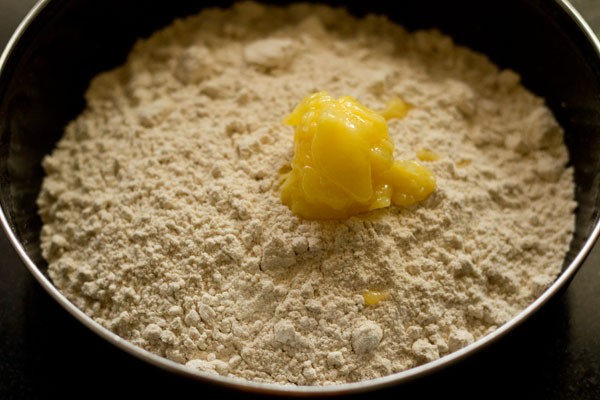
2. With your fingertips, mix the ghee with the flour very well.
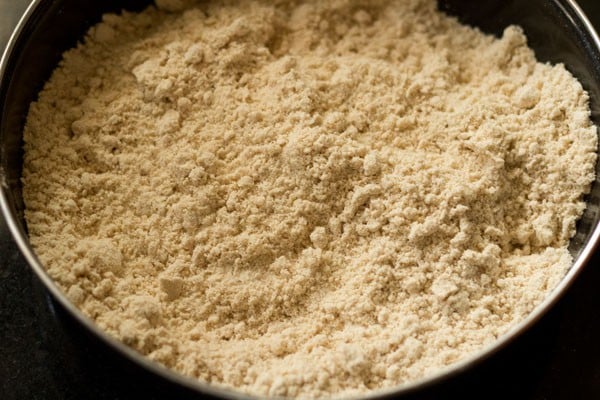
3. When you press the flour-ghee mixture in your palm, you should get a flour lump like shown in the picture below. The mixture should be able to hold itself together without falling apart.
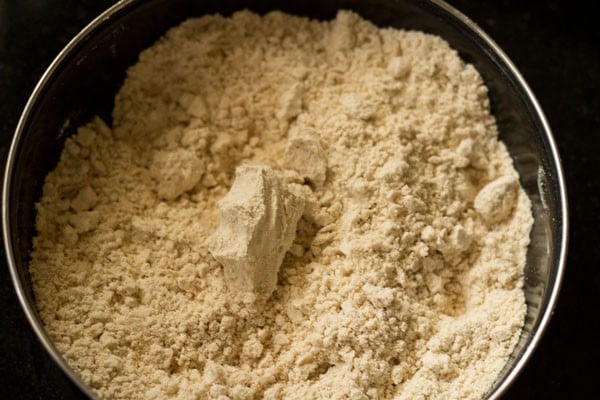
4. Now, add water in parts. Depending on the quality of flour, you can add less or more water. I added ½ cup water.
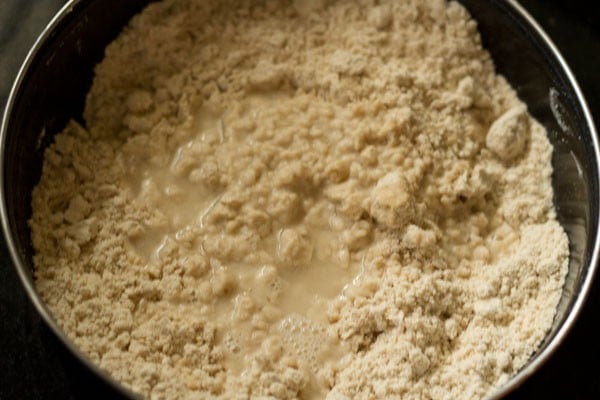
5. Begin to knead the dough. Add water as required. If you use all-purpose flour (maida), you will need less water.
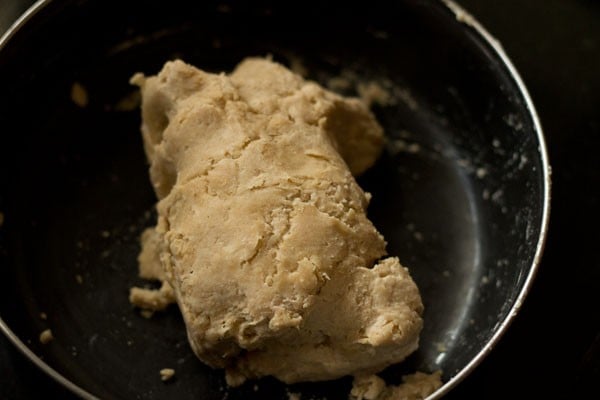
6. Knead to a firm semi-soft dough. Neither too soft, nor too hard. The dough should be not soft like the dough we make for chapatis or roti.
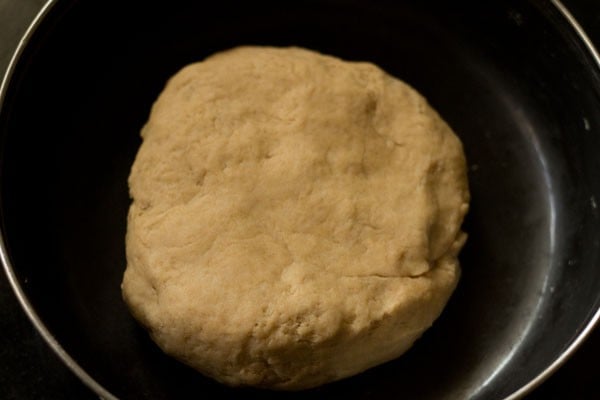
7. Divide the dough into 3 equal parts. Cover with a lid.
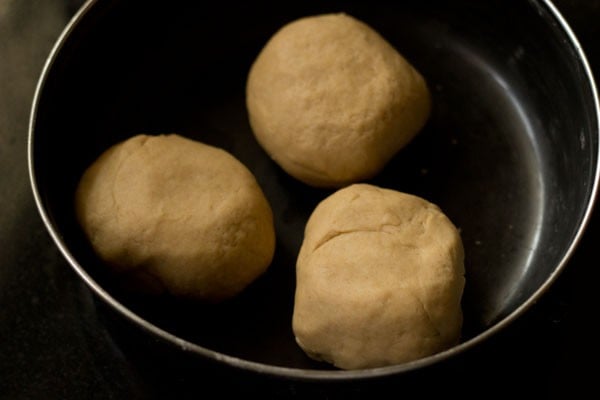
8. Take one part and roll into a thick paratha of 7 to 8 inches in diameter.
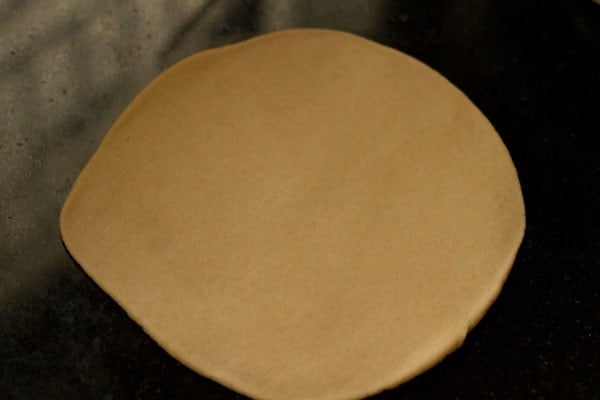
9. With a knife make squares or diamond shapes on the rolled dough, by slicing criss cross or vertically-horizontally.
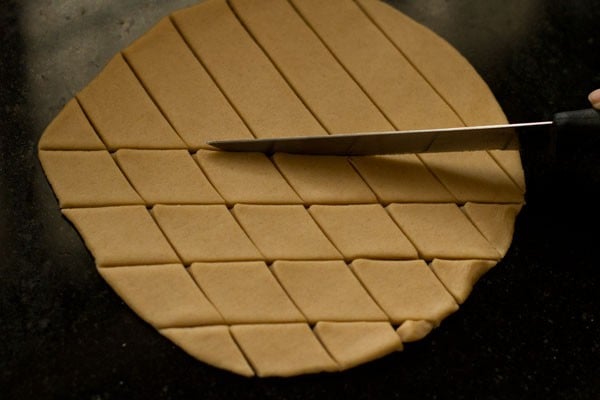
Make Khurma
10. Heat oil for deep frying in a kadai or pan. Test the oil temperature by adding a small piece of the dough in the pan. This small piece of dough should come up gradually and quickly on the surface.
If it comes slowly, the oil has a lower temperature and if it comes up too quickly, the oil has high temperature. I fried on medium heat. You can regulate the heat while frying, by increasing or decreasing it.
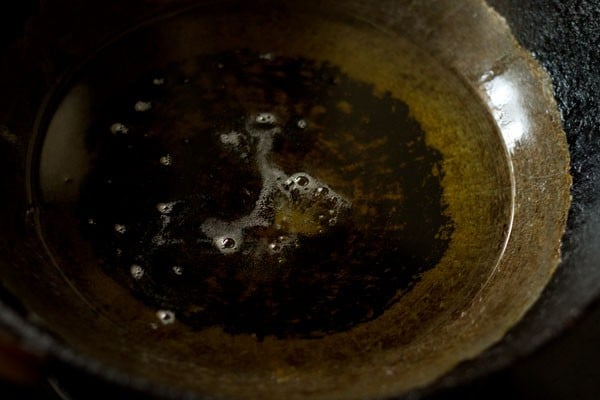
11. Gently, slid the cut diamonds from the dough, in the medium hot oil.
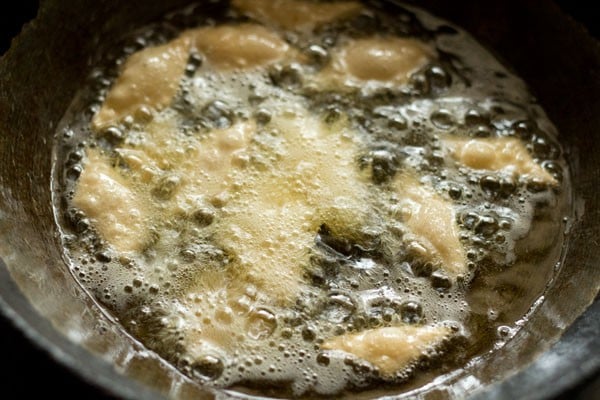
12. Depending on the size of the pan, you can add more or less. But make sure that there is some space while frying them.
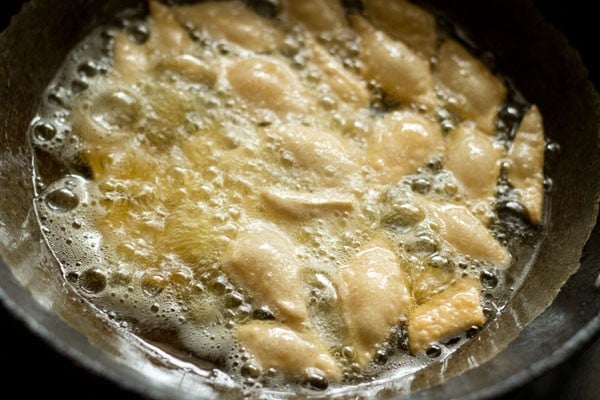
13. When the Shakkarpare are crisp and light golden, turn over and fry.
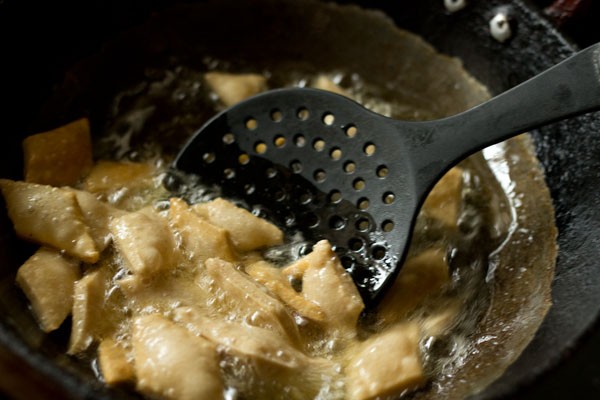
14. Keep on frying them and turning, as and when needed for even frying.
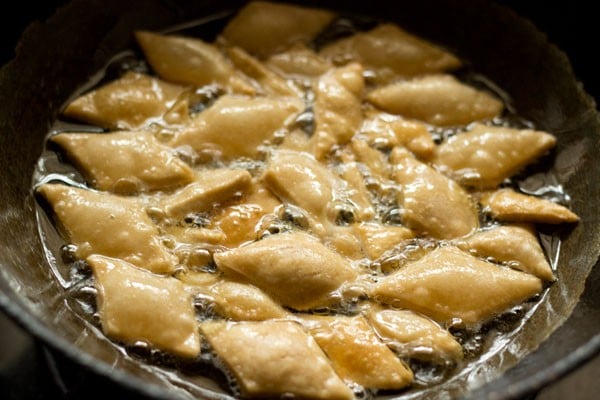
15. Fry till all of them turn golden.
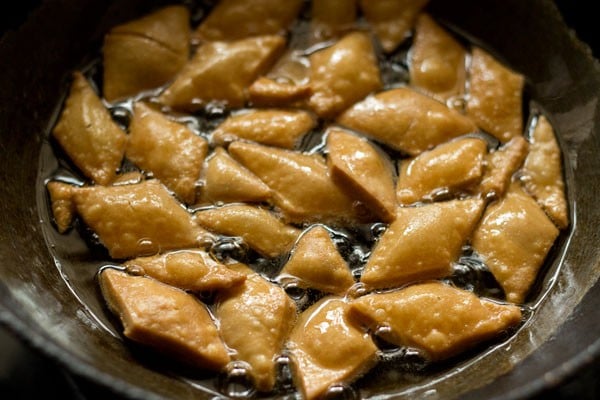
16. Remove with a slotted spoon and place Shakkarpare on kitchen paper towels to remove excess oil.
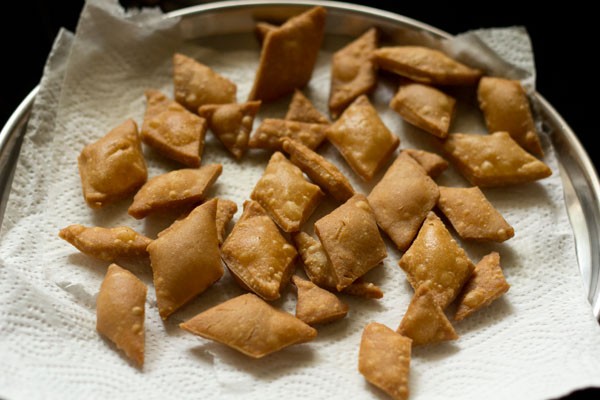
17. Continue to prepare and fry them as mentioned in the above steps. When you begin frying the last batch, you can start preparing the sugar syrup.
Let all the Shakkarpare cool completely to room temperature, before you add them in the sugar syrup.
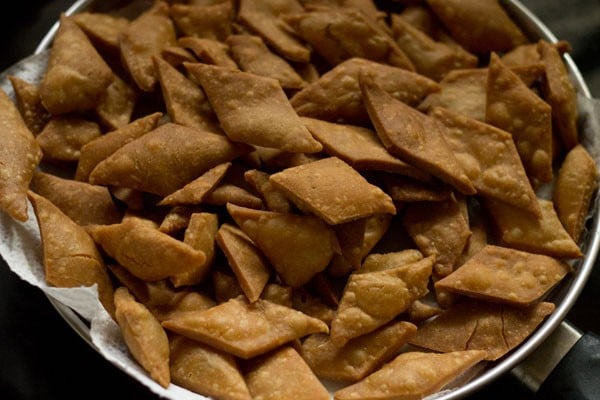
Make Sugar Syrup
18. Take 1 cup sugar (150 grams) in another kadai or pan.
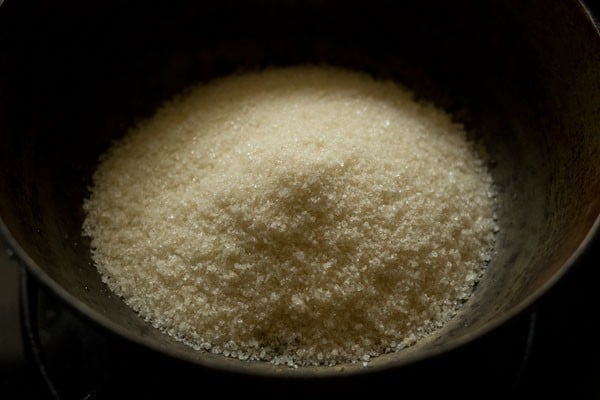
19. Add ½ cup water.
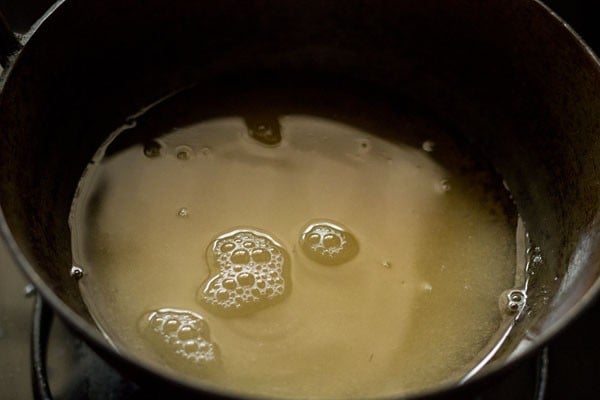
20. Keep the pan on low to medium heat. Stir, so that the sugar dissolves.
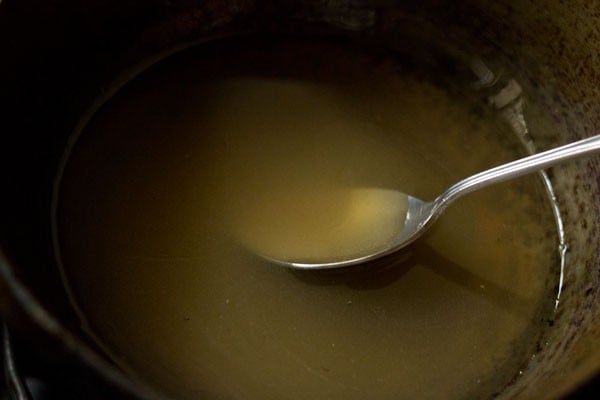
21. Continue cooking the sugar syrup till it starts bubbling and getting sticky. You can add some saffron strands in the sugar syrup, to get orange or yellow colored Shakarpara.
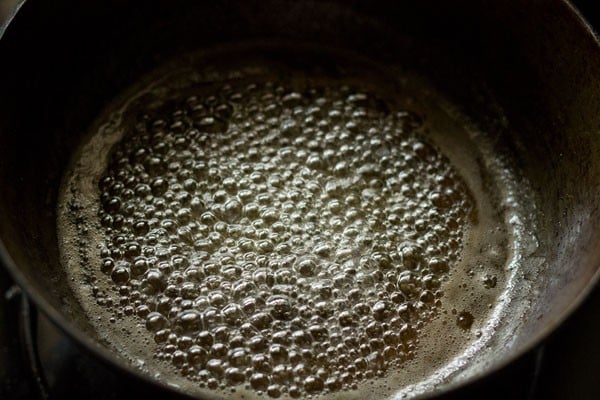
22. Simmer till you get a 2 to 3 thread consistency in the sugar syrup. To check the consistency, take a bit of the syrup in a spoon.
Let it become warm and then take the syrup between your forefinger and thumb. Press and separate the fingers.
You should see 2 to 3 thread consistency in the sugar syrup. The sugar syrup is quite hot and can burn your fingers. So, let it become warm or cool down, before you test.
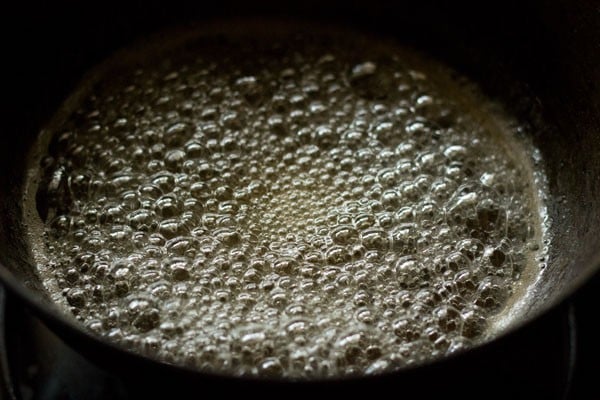
Coat Shakkarpare With Sugar Syrup
23. Switch off the heat as soon as the sugar syrup achieves a 2 to 3 thread consistency in it. Quickly, add all the Shakkarpare in the syrup.
The sugar syrup has to reach 2 to 3 thread consistency, otherwise the Shakarpara or Khurma will become soggy, as they will absorb the sugar syrup.
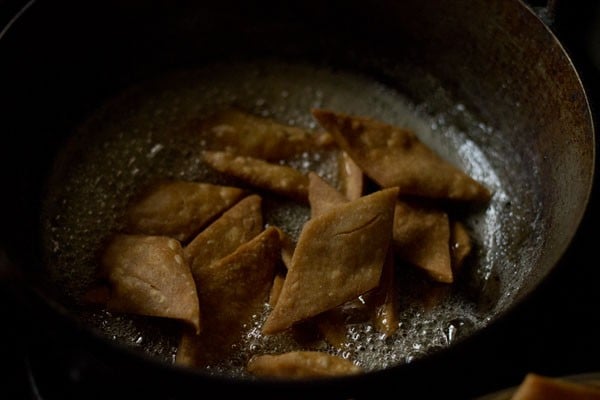
24. Briskly stir and toss well, so that all the Shakkarpare are coated with the sugar syrup.
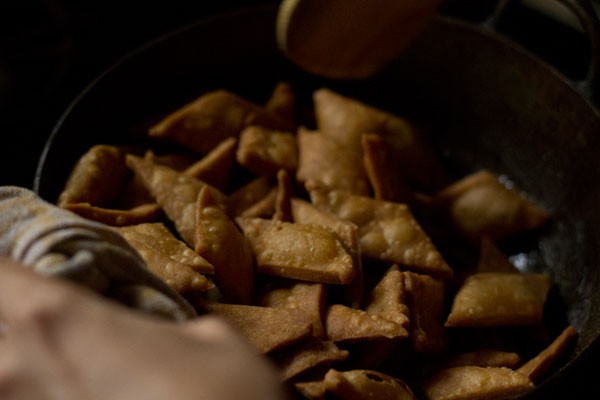
25. The sugar syrup crystallizes soon.
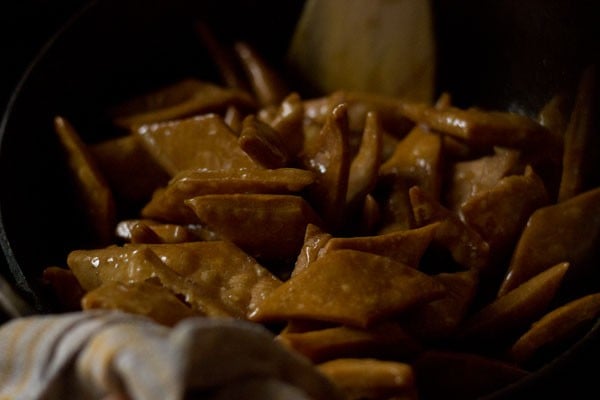
26. So, mix very well and be quick.
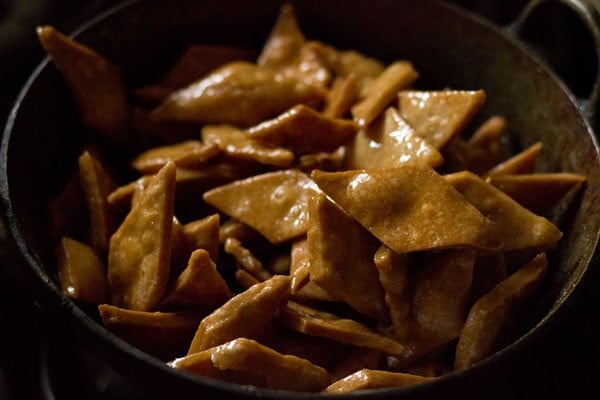
27. Take Shakkarpara on a plate and allow them to cool to room temperature. The sugar syrup will crystallize on cooling.
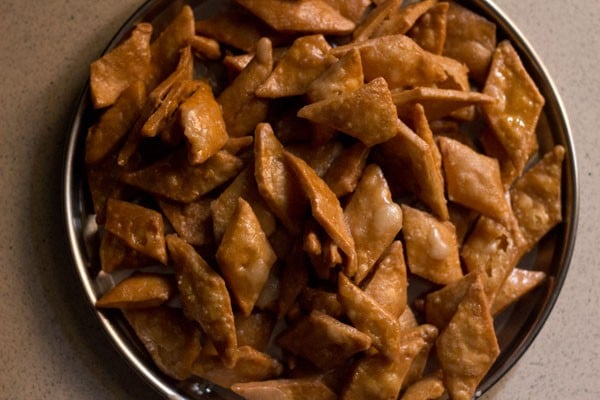
28. Once cooled, store Shakkarpare or Khurma in an air-tight box or jar at room temperature. These stay good for a month.
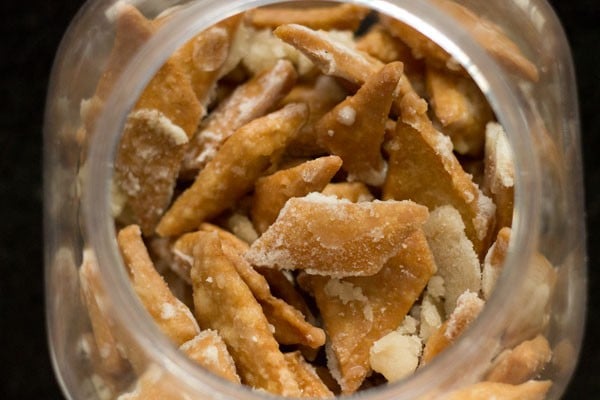
29. Serve Shakkarpare with tea or have them as a snack any time of day.
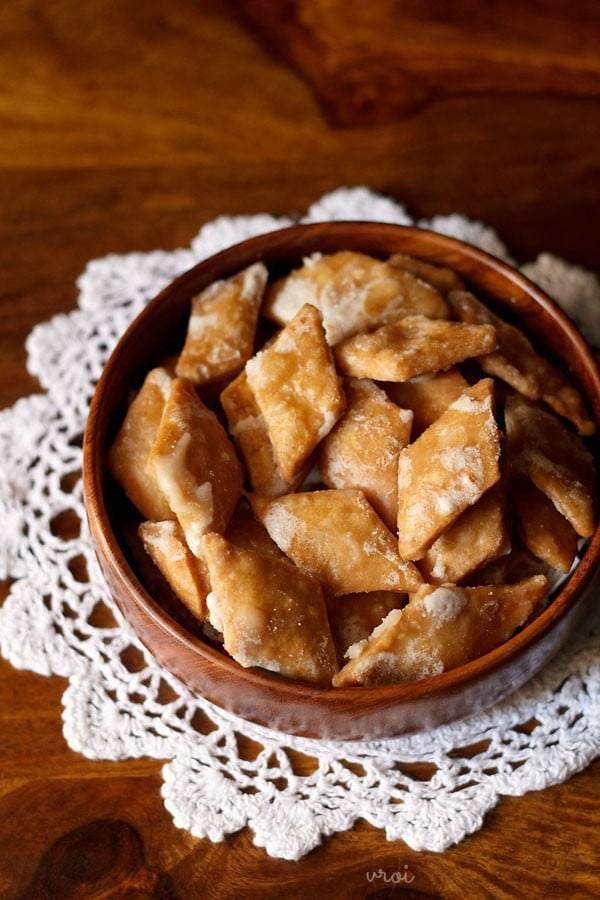
Expert Tips
- You can make this snack with all-purpose flour (maida) in place of whole wheat flour (atta). In place of ghee, you can use oil.
- Once you press the flour-ghee mixture in your palm, you should get a flour lump. Which means that the mixture should be able to hold itself together and not fall apart.
- Fry the shakkarpare on medium heat. Frying on a high heat will make them brown too fast leaving the inside dough undercooked. When frying on a low heat the shakkarpare will absorb more oil.
- The quantity of water that goes in the dough will depend on the quality of flour. If you are making the recipe with all-purpose flour, you will need less water.
- You should knead a firm and semi-soft dough. It should not be soft like a chapati dough.
- Make gudpare with the same recipe. Add same quantity of jaggery, in place of sugar.
- The sugar syrup should be cooked till it achieves a 2 or 3 thread consistency. If not, then the Khurma will turn soggy as it will absorb the syrup. Adding some saffron in the sugar syrup will give nice yellow or orange colored Shakkarpare.
- You can store the Khurma in air-tight containers for a few months.
More Diwali Sweets To Try!
Sweets Recipes
Sweets Recipes
Sweets Recipes
Sweets Recipes
Please be sure to rate the recipe in the recipe card or leave a comment below if you have made it. For more vegetarian inspirations, Sign Up for my emails or follow me on Instagram, Youtube, Facebook, Pinterest or Twitter.
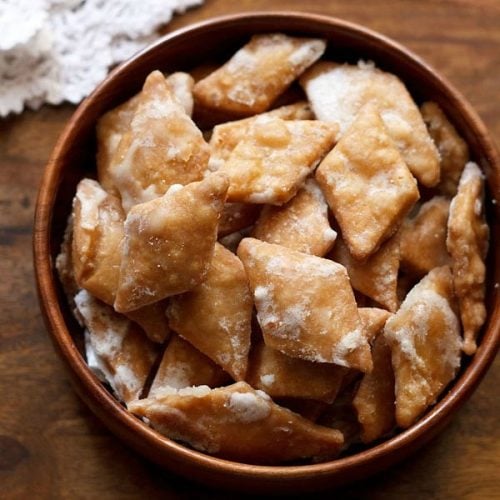
Shakarpara Recipe | Khurma | Shakkarpare
Ingredients
For the dough
- 240 grams whole wheat flour (atta) or 2 cups whole wheat flour
- 2 tablespoons Ghee
- ½ cup water or add as required
For sugar syrup
- 1 cup sugar – 150 grams, can also use 1 cup grated or powdered jaggery
- ½ cup water
- 10 to 12 saffron strands (kesar), optional
Other ingredients
- oil – as required for deep frying
Instructions
Making Shakarpara Dough
- Take whole wheat flour in a mixing bowl or pan. Add 2 tablespoons of ghee. The ghee should be at room temperature and in a semi solid state. Instead of whole wheat flour you can also take all purpose flour and oil instead of ghee.
- With your fingertips, mix the ghee with the flour very well.
- When you press the flour and ghee mixture in your palm, you should get a flour lump like shown in the picture below. The mixture should be able to hold itself together without falling apart.
- Now add water in parts. Depending on the quality of flour, you can add less or more water. I added ½ cup water.
- Begin to knead the dough. Add water as required. If you use all-purpose flour, you will need less water.
- Knead to a firm semi soft dough. Neither too soft nor too hard. The dough should be not soft like the dough we make for chapatis.
- Divide the dough into three equal parts. Cover with a lid.
- Take one part and roll into a thick paratha of 7 to 8 inches in diameter.
- With a knife make squares or diamond shapes on the rolled dough, by slicing criss cross or vertically-horizontally.
Frying Shakkarpare
- Heat oil for deep frying in a kadai or pan. Test the oil temperature by adding a small piece of the dough in the pan. This small piece of the dough should come up gradually and quickly on the surface. If it comes slowly, the oil has a lower temperature and if it comes up too quickly, the oil has high temperature. I fried on medium heat. You can regulate the heat while frying by increasing or decreasing it.
- Slid the cut diamond shaped dough in the medium hot oil.
- Depending on the pan size, you can add more or less. But do make sure that there is some space while frying them.
- When the shakkarpara are crisp and light golden, turn over and fry.
- Keep on frying them and turning as and when needed for even frying.
- Fry till all of them turn golden.
- Remove with a slotted spoon and drain shakkar pare on kitchen paper towels to remove excess oil.
- Continue to prepare the shakkarpara and fry them as mentioned in the above steps.
- When you are begin frying the last batch, you can start preparing the sugar syrup. Let all the shakkarpara come to room temperature, before you add them in the sugar syrup.
Making sugar syrup
- Take 1 cup sugar in another kadai or pan. Add ½ cup water.
- Keep the pan on a low to medium heat. Stir so that the sugar dissolves.
- Continue cooking the sugar syrup till it starts bubbling and getting sticky. A suggestion here is to add some saffron strands in sugar syrup to get orange or yellow colored shakkarpara.
- Simmer till you get a 2 to 3 thread consistency in the syrup. To check the consistency, take a bit of the syrup in a spoon. Let it become warm and then take the syrup between your forefinger and thumb. Press and separate the fingers. You should see two to three threads in the sugar syrup.
- Once the two to three thread consistency is reached, quickly add all the shakkarpara in the syrup.
- Briskly stir and toss well, so that all the shakkarpara are coated with the sugar syrup.
- The sugar syrup crystallizes soon, so mix very well and be quick.
- Now take all the shakkarpara in a plate and allow them to come at room temperature. The sugar syrup will crystallize on cooling.
- Once all of them cool down, store shakkarpara in an air-tight box or jar. These stay good for a few months.
Notes
- The dough has to be semi-soft. Do not make it soft like a roti or naan dough.
- Fry on medium to medium-hight heat. On a high heat, the shakarpara will cook faster from outside but the inside dough can be undercooked. On a low heat, the shakkarpare will absorb more oil.
- Instead of sugar, you can use jaggery and make gudpare. You will need to cook the jaggery syrup to a 2 to 3 string consistency. Use 1 cup of jaggery powder or grated/finely chopped jaggery.
- The recipe can be scaled easily to make a small or a large batch of shakkarpare.
- Note that the approximate nutrition info is for the entire lot of shakkarpare made from this recipe.
Nutrition Info (Approximate Values)
This Shakarpara recipe post from the archives first published in October 2015 has been updated and republished on 11 September 2022.
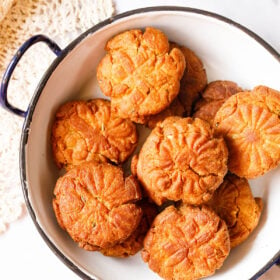
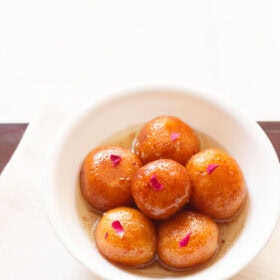
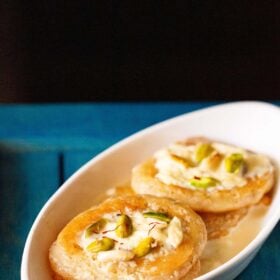
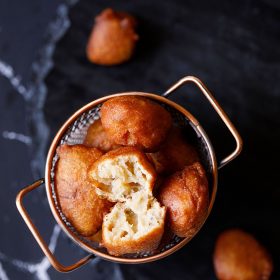
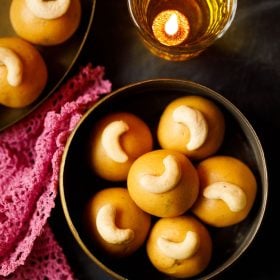
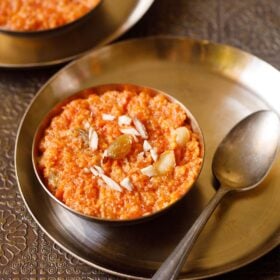
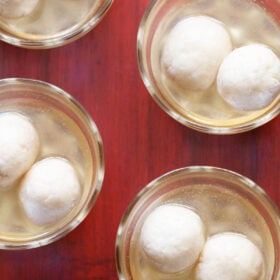
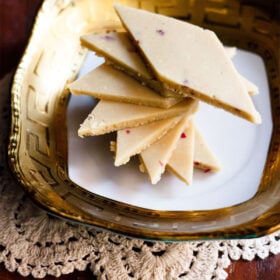








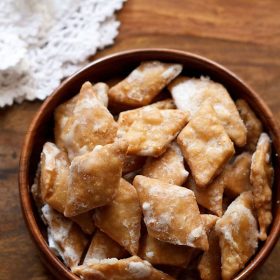
I loved this recipe!What beautiful pictures!Really appreciate this blog!:) Namaste
Hello,i hv made shakkarpare today exactly following the way u instructed, it came out to be very tasty and crispy, i love the way u explain each and everything. Thank you, and will b looking forward for more
alisha, thanks for this feedback on shakkarpare recipe. glad to know that the recipe came out well for you. welcome and happy cooking.
Shakkarpare made awesome!
thankyou so much savi 🙂
Hi
I tried this recipe today everything is fine but my shakarpare is not crispy!! They are like eating puri with sugar….I did exactly d same way u said…they are semi crisp and soft in middle (not too soft,while chewing there is no crisp)
did you allow them to cool completely before adding to sugar syrup. how was the texture before you added them to the sugar syrup. the reason for softness could also be if the dough is soft or has been kneaded with more water. a soft dough will give soft shakkapares.
awesome as usual.
thanks nivedita 🙂
Very good shankar pare